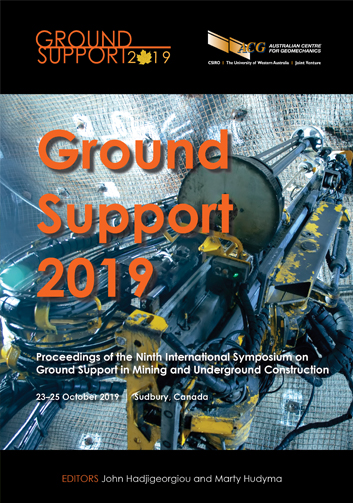Relating measured deformation to support load

|
Authors: Milne, DM |
DOI https://doi.org/10.36487/ACG_rep/1925_05_Milne
Cite As:
Milne, DM 2019, 'Relating measured deformation to support load', in J Hadjigeorgiou & M Hudyma (eds), Ground Support 2019: Proceedings of the Ninth International Symposium on Ground Support in Mining and Underground Construction, Australian Centre for Geomechanics, Perth, pp. 101-108, https://doi.org/10.36487/ACG_rep/1925_05_Milne
Abstract:
This research looks at linking the magnitude and location of field deformation to the load on cable bolt support as it approaches failure. There has been a significant body of research conducted on the behaviour of cable bolt support in underground mining, especially in the 1980s and 1990s. This research has primarily concentrated on determining the critical cable pull-out strength based on the peak loads that can be mobilised through friction between the cable to grout interface. This paper looks at the case where adhesion and friction are both contributing to the cable to grout bond, before movement of the free end of the cable. It should be noted that when peak load is considered, a factor of safety may be applied to account for uncertainties with cable bolt pull-out strength. This work relating cable load to field deformation, can be augmented by techniques developed to extrapolate limited, discrete, field deformation to an overall surface deformation pattern. Field deformation is easily measured with extensometers and further information can be gained with borehole cameras. In some cases, such as in foliated or bedded hanging walls, beam or plate type deformation occurs and the magnitude of deformation, can be tied to opening geometry. This can enable localised information on deformation, collected by extensometers, to be extrapolated to areas without instrumentation coverage, which can then be related to a distribution of cable load.
Keywords: field deformation, extensometers, cable bolts
References:
Fuller, TJ 1983, ‘Cable support in mining – a keynote lecture’, Proceedings of the International Symposium on Rock Bolting, Abisko, pp. 511–522.
Goris, JM 1990, Laboratory Evaluation of Cable Bolt Supports, Part 1. Evaluation of Supports Using Conventional Cables, Bureau of Mines Report of Investigation, vol. 9308.
Goris, JM, Nickson, SD & Pakalnis, R 1994, Cable bolt support technology in North America, Bureau of Mines Information Circular 9402, US Deptartment of the Interior, p. 51.
Hutchinson, DJ & Diederichs, M 1996, Cablebolting in Underground Mines, BiTech Publishers Ltd, Richmond, 406 p.
Martin, L, Milne, D, Ruest, M & Pakalnis, R 2004, Evaluations of Instrumented Cable Bolts in Cement Grout to Determine Physical and Numerical Modeling Properties, National Institute of Occupational Health and Safety (NIOSH), Report of Investigations 9662, 14 p.
Milne, D 1989, internal Noranda Technology report.
Milne, D 1997, Underground Design and Deformation Based on Surface Geometry, PhD thesis, The University of British Columbia, Vancouver.
Milne, D, Gendron, A & Hamilton, R 1992, Cable bolt research summary report, internal report, Noranda Technology Centre, Montreal.
Milne, D, Pakalnis, R, Grant, D & Sharma, J 2004, ‘Interpreting hanging wall deformation in mines’, International Journal of Rock Mechanics & Mining Sciences, vol. 41, pp. 1139–1151.
Reichert, RD 1990, A Laboratory and Field Investigation of the Major Factors Influencing Bond Capacity of Grouted Cable Bolts, masters thesis, Queen’s University, Kingston.
Reichert, RD, Bawden, WF & Hyett, AJ 1992, ‘Evaluation of design bond strength for fully grouted cables’, CIM Bulletin, vol. 85, no. 962, pp. 110–118.
Stillborg, B 1984, Experimental Investigation of Steel Cables for Rock Reinforcement in Hard Rock, doctoral thesis, Luleå University, Luleå.
© Copyright 2026, Australian Centre for Geomechanics (ACG), The University of Western Australia. All rights reserved.
View copyright/legal information
Please direct any queries or error reports to repository-acg@uwa.edu.au
View copyright/legal information
Please direct any queries or error reports to repository-acg@uwa.edu.au